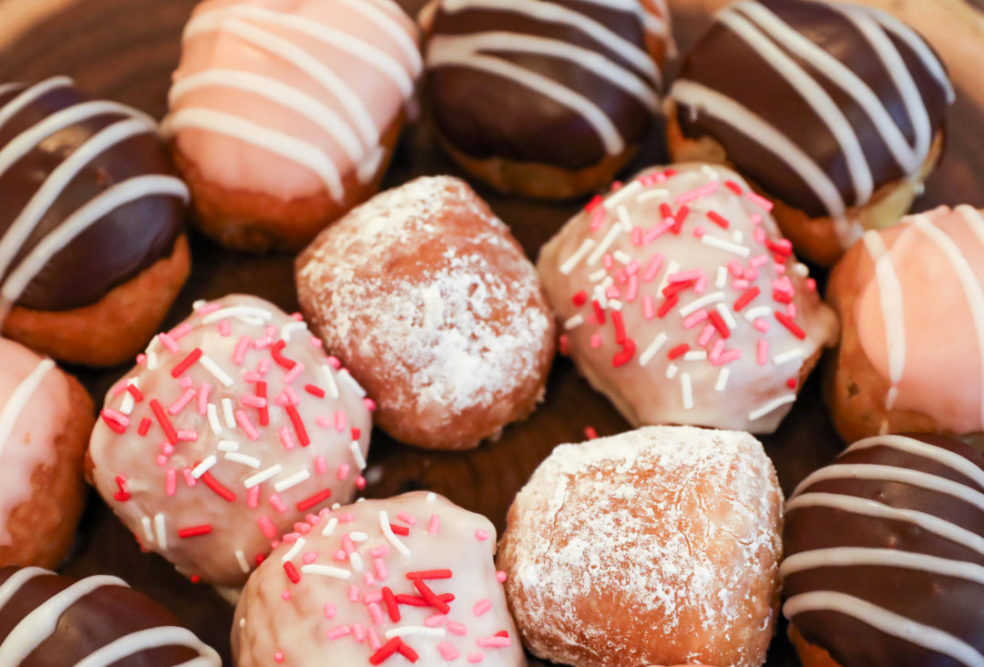With National Donut Day approaching on June 3 (it’s always the first Friday in June), now is the perfect time to start planning those donut promotions.
First, think about all-day promotions. Donuts may use many different breakfast foods as toppings, including cereal, bacon, and fruit, but donuts are no longer a breakfast-only item. According to a survey from Dawn Foods, 87% of people eat them in the morning, 38% in the afternoon, 33% in the evening and 23% late at night.
As for flavor trends, according to Vincent Barcelona, director of sales-national accounts and culinary at Stratas Foods, these are some of the current flavor trends for donuts:
- Tiramisu Filled Donuts
- Crème Brulee Glazed Donuts
- Chocolate Babka Donuts
- Yeasted Blueberry Donut with Candied Ginger Crumbs
- Meltaway Toffee Crumb Donut
- Fruit Punch Glazed and Earl Gray Tea Crumbs
- Chocolate Mousse Challah Donut
Glazed cruller bites
Convenience is a big deal, as evidenced by packaging options and smaller donut options. Glazed cruller bites are among the top sellers at Grebe’s Bakery. Established in 1937 in Milwaukee, Grebe’s famous donuts and baked goods are sold at local Speedway, Sentry, Sendik’s, Woodman’s or Piggly Wiggly, in addition to many other locations throughout southeastern Wisconsin.
A year ago, Dickinson, ND-based bakery manufacturer Baker Boy launched a new line of individually wrapped donuts under The Donut Hole® brand. A true product of the pandemic, when food safety is more important than ever, these donuts are perfect for foodservice and retail alike. The Donut Hole® Individually Wrapped Donuts offer operators a solution to this potentially lasting trend with a new line of packaged and fully finished retail-ready donuts. The branded packaging also includes retail-ready essentials such as Nutrition Facts, ingredient information and a scannable UPCs for each donut. In addition, Baker Boy offers other convenience items such as ready to finish cake donut holes and fully finished cinnamon sugar cake donut holes.
Temperature control
The most critical area when making raised product, but one that is overlooked the most, is temperature. You must be constantly aware of temperature to produce consistently good, raised product, according to BakeMark. Pay close attention to the temperature of BakeMark yeast raised donut mixes, the room, your tap water, dough, and shortening. Variances of these temperatures will greatly affect the finished product.
Years of trial and error have proven that raised product dough should be cut when it is about 82° F to 85° F. To make sure the dough is the correct temperature, you must consider a few outside factors. For example, if the ambient temperature of the room and dry mix is cold, you need to add warm water for your dough to be the correct temperature at cutting time, according to BakeMark. On the other hand, if your room and dry mix are very warm, the water you add should be cool. An “instant read thermometer” is a must.
When your donuts are ready to fry, make sure your shortening is 385° F. Frying at higher temperatures prevents the donut from expanding during the cooking time. Frying at lower temperatures could result in uncooked dough and excess shortening absorption. Take some time to be sure your fryer thermostat is always working properly and giving correct temperature indications.
Roger Daniels, vice president research, development, innovation and quality for Stratas Foods, emphasizes the importance of selecting the right oil.
“For best results utilize a frying shortening based on a high-oleic oil,” he said. “The chemistry of what defines a high-oleic oil provides the perfect frying medium to achieve the balance between doughnut visual attributes and flavor. We recommend 100% high-oleic soybean oil or oils made from high-oleic sunflower and cottonseed oils. If a high-oleic oil is not available, a basic high quality soybean oil would be the next choice.”
Temperature is also important. For any of the oils types the best oil temperature for quality donuts is at or around 335°F. In fact, a frying temperature that is too low or two high is the most common mistake made in donut preparation. Too low of a temperature and the doughnut is underdeveloped in texture from excess oil pick-up and exhibits a light or low donut color. Too high a temperature and the doughnut will be too dark in color and the flavor may be off.
Drop-in solution
United Soybean Board fats & oils expert Frank Flider points out that high oleic soybean shortening offers a true drop-in solution to partially hydrogenated oils,
In 2015, FDA released its final determination that Partially Hydrogenated Oils (PHOs) are not Generally Recognized as Safe (GRAS). The determination is based on extensive research into the effects of PHOs, as well as input from stakeholders during the public comment period.
PHOs are the primary dietary source of artificial trans fat in processed foods. Removing PHOs from processed foods could prevent thousands of heart attacks and deaths each year. To learn more about trans fat, see the government’s Trans Fat page. It’s important to note that trans fat will not be completely gone from foods because it occurs naturally in small amounts in meat and dairy products and is present at very low levels in other edible oils.
“High oleic soy shortening is chemically very close to PHOs in composition and offers the same kind of performance to oils with no trans fat. We have done quite a lot of research, and high oleic soy shortening really is a drop-in solution to PHOs. The shortening manufacturers have pretty much nailed it. High oleic soy shortenings are readily available,” Flider said.
Flider explains that 25-30% of the donut is shortening, so it is extremely important to get it right – to achieve the right rise, the right spread, and the right star structure.
“Just make sure your frying temperature is correct,” he said.

